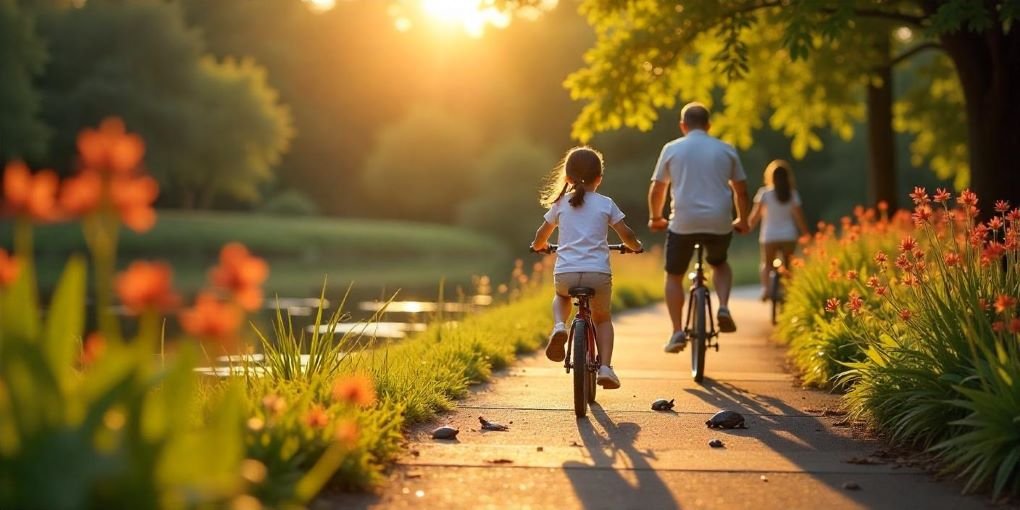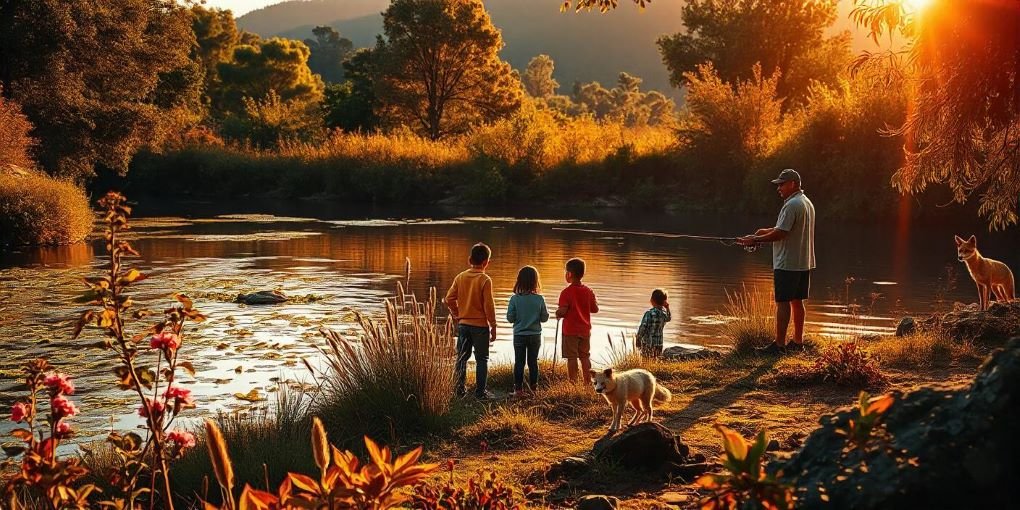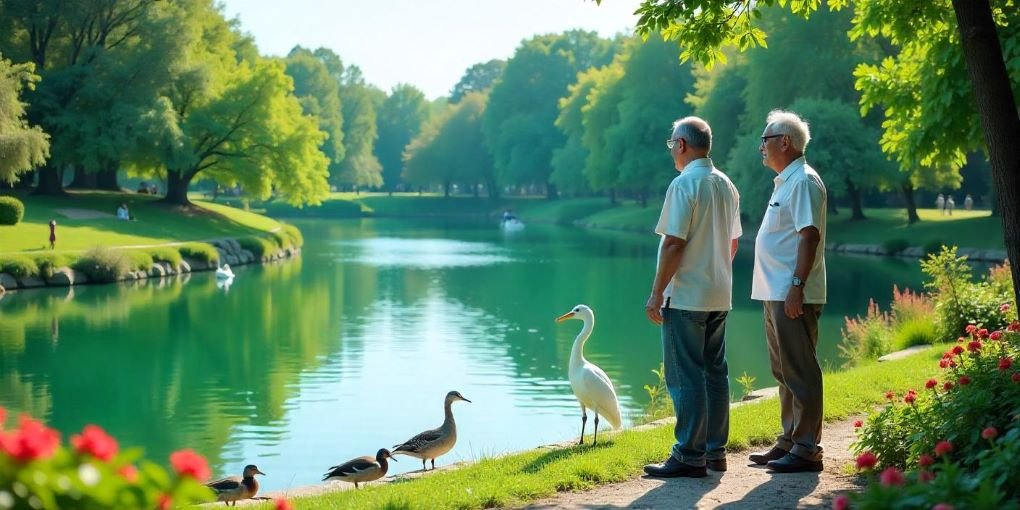Lakeside gardens offer a unique opportunity to blend human enjoyment with nature preservation. By designing your Wildlife Habitats in Lakeside Gardens to support wildlife, you create an ecosystem that fosters biodiversity, encourages the presence of beneficial animals, and contributes to environmental health. Whether your garden surrounds a small pond or overlooks a vast lake, strategic planning can transform it into a haven for local wildlife, providing shelter, food, and a safe space for various species.
The Benefits of Wildlife Habitats in Lakeside Gardens
Wildlife habitats in lakeside gardens not only benefit the environment but also offer enriching experiences for the homeowner. Here are some key benefits:
- Increased biodiversity: Supporting native plants and animals helps maintain a balanced ecosystem.
- Natural pest control: Birds and beneficial insects can help control garden pests without chemical pesticides.
- Pollination: Bees, butterflies, and other pollinators contribute to healthy plant growth.
- Enhanced beauty and movement: Wildlife adds a dynamic element, making your garden more vibrant and engaging.
- Conservation efforts: Creating habitats aids in the preservation of at-risk or threatened local species.
Essential Elements for a Wildlife-Friendly Lakeside Garden
To create a successful wildlife habitat, it’s important to include elements that cater to the basic needs of animals: food, water, shelter, and safe nesting sites.
Food Sources
- Native plants: Incorporate native shrubs, trees, and flowering plants that produce nectar, seeds, and berries.
- Fruit-bearing plants: Bushes like elderberry, dogwood, and serviceberry provide essential nutrients for birds and small mammals.
- Flowering perennials: Coneflowers, milkweed, and black-eyed Susans attract pollinators and other beneficial insects.
- Herbs and grasses: Varieties like lavender and ornamental grasses offer seeds and habitat for smaller creatures.
Water Access
- Birdbaths and water dishes: Ensure they have gently sloped sides or perches for small animals.
- Small ponds or pools: Create shallow edges to allow amphibians and insects to enter and exit safely.
- Water features with movement: Fountains or waterfalls attract birds, who enjoy the sound and sight of moving water.
Shelter and Nesting Sites
- Native trees and shrubs: Provide natural cover and nesting areas for birds and mammals.
- Dead wood and brush piles: Offer habitat for insects, small mammals, and reptiles.
- Rock piles and log structures: Create micro-habitats that help amphibians and beneficial insects thrive.
- Nesting boxes: Install boxes designed for specific bird species, such as bluebirds or chickadees, to encourage them to settle in your garden.
Safe Zones and Hiding Spots
- Tall grasses and dense vegetation: Essential for hiding and foraging for many creatures.
- Natural fencing or barriers: Use hedgerows or plant clusters to create privacy and safety from predators.
- Minimized human disturbance: Dedicate certain areas of the garden solely to wildlife, minimizing foot traffic and noise.
Choosing the Right Plants for Wildlife Habitats
Choosing the right plants ensures that your garden can support wildlife throughout the year. Below are some plant options and their benefits:
Native Trees
- Oak trees: Host to numerous insects, which in turn feed birds.
- Willow trees: Provide nesting material and support caterpillar growth.
- Maple and birch: Offer seeds and shelter.
Shrubs and Bushes
- Hawthorn and holly: Produce berries that sustain birds during winter.
- Raspberry and blackberry bushes: Create dense cover and offer fruit for various animals.
- Spirea and viburnum: Attract butterflies and provide nectar-rich blooms.
Flowering Plants
- Milkweed: A critical plant for monarch butterflies.
- Goldenrod and asters: Late-blooming flowers that support pollinators as the seasons change.
- Bee balm and lavender: Popular among bees and hummingbirds.
Water Features and Their Impact on Wildlife
Integrating water features into your lakeside garden greatly enhances its attractiveness to wildlife. A well-planned water element can serve as a drinking source, bathing area, and habitat for various creatures.
Creating Wildlife Ponds
- Shallow edges: These provide safe access for animals to drink and bathe.
- Aquatic plants: Water lilies, cattails, and sedges offer shelter for fish and amphibians while helping to maintain water quality.
- Floating logs or rocks: These serve as perches for birds and resting spots for turtles.
Fountains and Waterfalls
- Running water: The sound attracts birds and can deter mosquitoes by disrupting standing water.
- Natural filtration: Incorporate a water feature with plants that filter and oxygenate the water to keep it clean.
Attracting Specific Wildlife Species

Each species has different needs, and you can customize your garden to attract particular wildlife.
Birds
- Seed feeders and suet cakes: Provide nourishment during colder months.
- Berry bushes and trees: Offer a natural food source.
- Nesting boxes: Place in quiet areas to encourage nesting.
Bees and Butterflies
- Pollinator-friendly plants: Incorporate a diverse selection of flowers that flower at various times to guarantee a continuous supply of food throughout the year.
- Avoid pesticides: Minimize or completely avoid the use of substances that may be detrimental to pollinators.
- Butterfly puddling stations: Create shallow dishes filled with water and flat stones for butterflies to rest on while drinking.
Amphibians and Reptiles
- Moist shaded areas: Construct shaded spots near water sources.
- Log piles and rock shelters: Provide safe havens for toads, frogs, and small lizards.
- Native aquatic plants: Offer cover and breeding areas for amphibians.
Small Mammals
- Dense plantings and ground cover: Protect rabbits, hedgehogs, and other small animals from predators.
- Brush piles: Serve as shelters and resting areas.
- Fruit trees: Attract squirrels and chipmunks looking for food.
The Importance of Wildlife Habitats in Lakeside Gardens
Wildlife habitats are crucial for maintaining ecological balance. Gardens near bodies of water, such as lakes or ponds, are particularly attractive to wildlife as they offer essential resources like water, food, and shelter.
Ecological Benefits
Creating a wildlife habitat in your lakeside garden enhances local biodiversity. The natural integration of plants and water bodies attracts a wide range of species, fostering a balanced ecosystem. Animals like birds, frogs, and insects not only find a haven but also help with natural pest control and pollination, leading to healthier plants and fewer garden maintenance needs.
Personal Benefits
Engaging with nature is known to reduce stress and promote well-being. Observing wildlife in your garden adds an element of tranquility and beauty, making your outdoor space more enjoyable and immersive.
Designing a Wildlife Habitat in Your Lakeside Garden
Creating a successful wildlife habitat involves understanding the specific needs of the wildlife in your region. The goal is to provide an environment that meets their basic needs: food, water, shelter, and breeding areas.
Food Sources
Ensure a steady food supply by planting a mix of native plants that produce seeds, berries, and nectar. These plants are more suited to local wildlife and thrive with minimal maintenance.
- Native Flowers: Choose flowering plants such as coneflowers, black-eyed Susans, and milkweed to attract bees, butterflies, and hummingbirds.
- Fruit-Bearing Shrubs: Incorporate shrubs like elderberry, serviceberry, and dogwood, which produce berries that feed birds and small mammals.
- Herbs and Grasses: Plant herbs such as lavender and grasses like fescue, which provide seeds and habitat for birds.
Water Features
Water is essential for wildlife survival. Since your garden is lakeside, leverage the natural water body and consider adding supplementary water sources.
- Birdbaths and Ponds: Shallow birdbaths with varying depths cater to different bird species. A small pond with native aquatic plants like cattails and water lilies can attract frogs and dragonflies.
- Flowing Water Features: Install a small waterfall or fountain to keep water moving, which prevents stagnation and attracts birds that prefer moving water for drinking and bathing.
Shelter and Safe Zones
Animals need safe places to rest, hide, and breed. Create these areas by adding various structures and natural elements.
- Native Trees and Shrubs: Wildlife Habitats in Lakeside Gardens provide shelter, nesting spots, and food sources.
- Rock Piles and Logs: Place logs and rocks in shaded spots to create micro-habitats for amphibians and small mammals.
- Brush Piles: Collect fallen branches and leaves to build brush piles, which are excellent for housing insects, reptiles, and birds.
Creating Specific Wildlife Areas

Each section of your lakeside garden can be designed to support specific types of wildlife. This thoughtful approach maximizes the use of space and ensures that a variety of creatures can thrive.
Butterfly and Pollinator Gardens
Pollinators are crucial for plant reproduction. A committed pollinator garden not only improves the aesthetics of your area but also aids bees, butterflies, and various helpful insects.
- Plant Diversity: Choose a mix of flowers that bloom at different times of the year to ensure a consistent food source.
- Avoid Pesticides: Refrain from using chemicals that can harm pollinators. Using some natural methods for pest control, such as introducing ladybugs and praying mantises.
- Water Sources: Place shallow dishes with water and stones for butterflies to land and drink safely.
Bird-Friendly Spaces
Birds bring life and song to a garden and contribute to pest control by eating insects.
- Nesting Boxes: Install birdhouses to attract cavity-nesting birds like bluebirds, chickadees, and wrens. Ensure the entrance hole size matches the preferred species.
- Berry-Producing Plants: Shrubs like holly, hawthorn, and juniper provide a natural food source that sustains birds through winter.
- Feeding Stations: Supplement natural food sources with bird feeders filled with seeds, suet, or nectar, especially in colder months.
Amphibian and Reptile Shelters
Amphibians like frogs and toads play a vital role in controlling insects, while reptiles contribute to the garden’s biodiversity.
- Moist Shelters: Create damp areas using overturned pots, logs, and rocks to provide shade and moisture.
- Water-Edge Planting: Place plants like sedge and reed grasses near the lake to offer cover and breeding spots for frogs and lizards.
- Leaf Litter: Allow leaves to accumulate in certain areas to create a natural hiding place for reptiles.
Seasonal Care for Wildlife Habitats
Adapting your garden to the changing seasons ensures wildlife has the resources they need throughout the year.
Spring Preparation
- Planting and Pruning: Introduce new native plants and prune existing shrubs to promote healthy growth.
- Nest Check: Clean out nesting boxes to make them ready for returning birds.
- Pond Maintenance: Clear debris from water features to prevent blockages and ensure clean water for animals.
Summer Maintenance
- Water Replenishment: Ensure birdbaths and small ponds remain full during hot months.
- Shade Creation: Position shade-tolerant plants to offer cool spots for smaller wildlife.
- Insect Control: Introduce beneficial insects to manage unwanted pests naturally.
Autumn Adjustments
- Leave Some Leaves: Avoid full-scale leaf raking, as leaf piles are valuable for insects and hibernating small mammals.
- Seed Heads: Let plants go to seed, providing birds with a natural food source.
- Shelter Reinforcement: Add additional brush piles or log structures to accommodate animals preparing for winter.
Winter Protection
- Provide Warmth: Use straw, mulch, and garden fabric to insulate vulnerable plant areas that small mammals might use for nesting.
- Feeding Stations: Keep bird feeders stocked to support birds when natural food is scarce.
- Ice-Free Water: Use a heated birdbath or de-icer to provide fresh water during freezing temperatures.
Common Challenges and Solutions

Maintaining a wildlife-friendly lakeside garden comes with its own set of challenges. Here’s how to address some common issues:
Predators
Wildlife habitats may attract predators, potentially disturbing smaller animals. Introduce dense vegetation and protected nesting boxes to offer safe zones.
Balancing Human Activity
Maintaining a space where wildlife and humans coexist harmoniously is essential. Designate areas of your garden for relaxation while setting aside undisturbed sections for wildlife.
Plant Diseases and Pests
Use companion planting and organic treatments to control disease and pests without harming wildlife.
Long-Term Benefits of a Wildlife Habitat
Over time, your lakeside garden will evolve into a resilient ecosystem. The increased presence of pollinators will lead to better plant health, and the natural pest control provided by birds and amphibians will reduce the need for chemical interventions. Additionally, your garden will become a sanctuary not only for wildlife but also for your enjoyment and mental well-being.
FAQs on Wildlife Habitats in Lakeside Gardens
Why are wildlife habitats important in lakeside gardens?
Wildlife habitats are essential because they support biodiversity, promote ecological balance, and provide food, water, and shelter for various species. These habitats contribute to a thriving ecosystem and help sustain local flora and fauna, creating a natural and sustainable environment.
What are the best plants to attract birds to my lakeside garden?
Native plants are the best choice as they are well-suited to local wildlife. Consider berry-producing shrubs like elderberry, holly, and serviceberry, as well as nectar-rich flowers such as bee balm and coneflowers. Trees like oak and willow also provide food and shelter for birds.
How do I make my garden friendly to pollinators like bees and butterflies?
To attract pollinators, plant a diverse range of flowers that bloom throughout the year. Include species like milkweed, lavender, and goldenrod, which offer nectar and pollen. Adding water sources and shelter such as rocks and logs also benefits these insects.
What types of water features are best for wildlife?
Naturalistic water features such as ponds, birdbaths, and small waterfalls are ideal. Ensure that water sources have shallow areas for easy access and use native aquatic plants to create a more inviting environment for amphibians and birds. Moving water features, like fountains, help attract birds and prevent mosquito breeding.
How can I create safe nesting spots for wildlife?
Install nesting boxes specifically designed for different bird species. Use trees and shrubs for natural nesting sites and create brush piles or dense vegetation for smaller mammals and reptiles. Make sure nesting boxes are in quiet, protected areas to minimize disturbance.
What strategies can I use to keep my garden conducive to wildlife all year long?
Adjust your garden practices seasonally:
Spring: Plant new native species and clean birdhouses.
Summer: Ensure water sources are full and provide shaded areas.
Autumn: Leave some fallen leaves and seed heads for wildlife.
Winter: Keep bird feeders stocked and provide warm shelters using mulch and garden fabric.
Are there any specific animals I can attract to help with pest control?
Yes, attracting birds, frogs, and beneficial insects like ladybugs and praying mantises can help control garden pests naturally. Birds consume caterpillars and beetles, while amphibians eat mosquitoes and other insects.
How can I protect wildlife habitats from predators?
To protect wildlife from predators, incorporate dense shrubs, tall grasses, and nesting boxes with secure, narrow openings. Creating rock piles and brush shelters also offers safe hiding spots for smaller animals.
Can I use fertilizers and pesticides in a wildlife habitat garden?
It’s best to avoid chemical fertilizers and pesticides in a wildlife habitat garden, as these can harm beneficial insects and animals. Choose organic fertilizers and use natural pest management techniques, such as companion planting and bringing in natural predators like ladybugs.
What challenges should I expect when creating a wildlife habitat?
Common challenges include balancing human activity with wildlife needs, managing plant diseases, and protecting smaller wildlife from predators. Address these by designing specific areas for wildlife that are separate from high-traffic zones, using natural deterrents for plant health, and adding protective shelters.
How do I attract amphibians and reptiles to my lakeside garden?
Amphibians and reptiles thrive in moist environments with plenty of cover. Create shaded areas using logs, rocks, and leaf litter near water sources. Plant sedge and reed grasses to offer protection and breeding spots.
What steps should I take to attract small mammals to my garden?
To attract small mammals like hedgehogs and rabbits, include dense plantings, ground cover, and brush piles for shelter. Fruit trees and berry bushes provide food sources, while minimizing human interference encourages these animals to feel safe.
What are some low-maintenance tips for a wildlife habitat?
Choose native plants that require minimal care, install birdhouses and bat boxes, and create natural shelters using logs and rocks. Leave some areas wild and undisturbed to foster a natural environment that wildlife will return to year after year.
How do wildlife habitats benefit my garden’s health?
Wildlife habitats promote natural pest control, improve pollination, and contribute to soil health through nutrient recycling. Birds, insects, and small animals help create a balanced ecosystem that supports plant growth and reduces the need for artificial interventions.
What precautions should I take when setting up water features?
Ensure that water features have gently sloped edges so animals can safely access and exit. Regularly clean birdbaths and ponds to prevent algae buildup and mosquito breeding. Adding a water filter or aerator helps maintain water quality.
